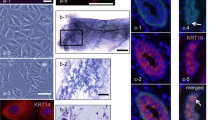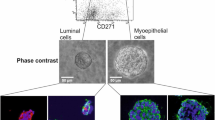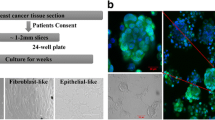Summary
A continous line of human breast carcinoma cells, VHB-1, was established in culture following collagenase treatment of an infiltrating duct cell carcinoma. The cells displayed an epithelial pattern and multiplied rapidly. Maintained in monolayer culture, the VHB-1 cells exhibited a 30-h doubling time and a plating efficiency of 20%. The cells possessed an abnormal karyotype with a mode of 70–74 chromosomes per cell. the karyotype was heavily rearranged and numerous marker chromosomes were found. Transplantation of the cells into nude mice produced tumors bearing histological resemblance to the original material. The VHB-1 cells contained significant levels of prolactin receptors, were steroid hormone (estrogen, progesterone, androgen, glucocorticoid) receptor positive, and were capable of functional differentiation in vitro. These characteristics make the VHB-1 cell line a suitable model for studying the biological properties of human breast tumors.
Similar content being viewed by others
References
Buchring GC, Hackett AJ (1974) Human breast tumor cell lines: identity evaluation by ultrastructure. J Natl Cancer Inst 53:21–629
Cailleau R, Young R, Olive M, Reeves WJ (1974) Breast tumor cell lines from pleural effusions. J Natl Cancer Inst 53:661–674
Duffy MJ, Duffy GJ (1979) Studies on progesterone receptors in human breast carcinoma: use of natural and synthetic ligands. Eur J Cancer Clin Oncol 15:1181–1184
Dutrillaux B, Viregas-Pequignot E (1981) High resolution R and G banding in the same preparation. Human Genet 57:93–95
Engel LW, Young NA (1978) Human breast carcinoma cells in continuous culture: a review. Cancer Res 38:4327–4339
EORTC Breast Cooperative Group (1979) Revision of the standards for the assessment of hormone receptors in human breast cancer; report of the second EORTC workshop, held on 16–17 March, 1979, in the Netherlands Cancer Institute. Eur J Cancer Clin Oncol 16:1513–1515
Franke WW, Appelhaus VS, Schmid E, Freudenstein C, Osborn M, Weber K (1979) Identification and characterization in mammalian tissues by immunofluorescence microscopy using antibodies to prekeratin. Differentiation 15:7–15
Haagensen DR (1981) Biochemical relationship between gross cystic disease and breast carcinoma. In: Haagensen CD, Bodian C, Haagensen DR (eds) Breast Carcinoma, risk and detection. Saunders, Philadelphia
Hiratsuka M, Senoo T, Namba M (1982) An improved short-term culture method for human mammary epithelial cells. Gann 73:124–128
Hofman AR, Paul SM, Axelrod J (1979) Catechol-estrogen synthesis and metabolism by human breast tumors in vitro. Cancer Res 39:4584–4587
Jirka M (1968) An α-2-globulin component present in sweat, saliva, tears, human milk, colostrum and cerumen. FEBS Lett 1:77–80
Lasfargues EY, Ozzello L (1958) Cultivation of human breast carcinomas. J Natl Cancer Inst 21:1131–1147
Olea-Serrano N, Devleeschouver N, Leclercq G, Heuson JC (1985) Assay for estrogen and progesterone receptors of breast cancer cell lines in monolayer culture. Eur J Cancer Clin Oncol 21:965–973
Peyrat JP, Djiane J, Kelly PA, Vandewalle B, Bonneterre J, Demaille A (1984) Characterization of prolactin receptors in human breast cancer. Breast Cancer Res Treat 4:275–281
Peyrat JP, Bonneterre J, Vandewalle B, Vennin Ph, Lesoin A, Lefebvre J (1986) Prolactin receptors and lactalbumin production in human breast cancer. Ann NY Acad Sci 464:427–430
Pinkus GS, Kurtin PJ (1985) Epithelial membrane antigen. A diagnostic discriminant in surgical pathology. Hum Pathol 16:929–940
Plata EJ, Acki T, Robertson DP, Chu AW, Gerwing BI (1973) An established cultured cell line (HBT-39) from human breast carcinoma. J Natl Cancer Inst 50:849–862
Puck TT, Marcus PI (1955) A rapid method for viable cell titration and clone production with Hela cells in tissue culture. The use of X-irradiated cells to supply conditionning factors. Proc Natl Acad Sci 41:432–437
Scatchard, G (1949) The attractions of proteins for small molecules and ions. Ann NY Acad Sci 51:600–672
Steiner AE, Wittliff JL (1958) A whole-cell assay for glucocorticoid binding sites in normal human lymphocytes. Clin Chem 31:1855–1860
Vandewalle B, Hornez L, Vennin P, Peyrat JP, Lefebvre J (1986) Further characterization of the light breast cyst fluid protein GCDFP-15. Biochimie 68:649–656
Yamame M, Nishiki M, Kataoka T, Kishi N, Amano K, Nakagawa K, Ohumichi T, Naito M, Ito A, Ezaki H (1984) Establishment and characterization of new cell line (YMB-1) derived from human breast carcinoma. Hirohima J Med Sci 33:715–720
Author information
Authors and Affiliations
Rights and permissions
About this article
Cite this article
Vandewalle, B., d'Hooghe, M.C., Savary, J.B. et al. Establishment and characterization of a new cell line (VHB-1) derived from a primary breast carcinoma. J Cancer Res Clin Oncol 113, 550–558 (1987). https://doi.org/10.1007/BF00390864
Received:
Accepted:
Issue Date:
DOI: https://doi.org/10.1007/BF00390864




